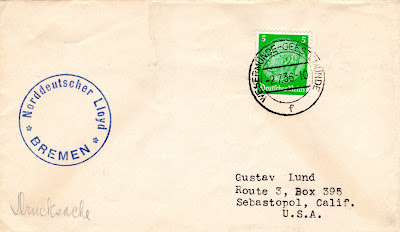The SS Bremen
The SS Bremen, a German ocean liner launched in August 1928, undertook her maiden voyage from Bremerhaven to New York on July 16 1929. She was of 51,656 tons and 286.1 metres in length, and carried over 2,100 passengers and 966 crew.She arrived in New York in 4 days, 17 hours, 42 minutes, taking the west-bound Blue Riband speed record from the “Mauretania”. On her return voyage, she took the east-bound Blue Riband in 4 days, 14 hours, 13 minutes. She was the only ocean liner to achieve two speed records on her first two voyages. She completed 190 transatlantic voyages, and was the first ocean liner of her size to traverse the Panama Canal.
A variety of postmarks are known, but manuscript and stamped cachets were applied for mail posted outside Germany. A Catapult Mail service, using a Heinkel He 12 seaplane mounted between the funnels (the catapult is just visible in the photo above), was in use from 1929 to 1936, when the speed of the Zeppelin “Hindenburg” made the service redundant. Catapult covers don't form part of my collection, as they are quite gaudy and usually covered in an abundance of cachets (reminiscent of the Tonga "Tin Can" covers). An excellent site on the catapult process and catapult mail can be found here
My preference lies with non-philatelic trans-atlantic mail.
The earliest cover I have is this registered cover from the USA to Belgium, dated January 10 1930.
This postcard was
posted from Bremen on January 15 1930, the return voyage of the USA-Belgium
registered cover shown above
The abbreviation “D. Bremen N.D.L.” means “Dampfer (steamer) Bremen, Nord-Deutscher
Lloyd”. The note is interesting. The writer says “will land Friday”. The card
is postmarked January 15 which was a Wednesday, indicating that the card was posted
half way through the journey, and accordingly would not arrive before the
writer had landed in New York, as no catapult mail flight has been recorded for
this voyage
Circular date stamps were also used, as shown on this postcard dated
May 3 1932
It has a CDS cancel which translates to “German-American Seapost, Bremen New York, Steamer Bremen”
Most covers can be found with manuscript or hand-stamped cachets.
A 1931 cover from France to Connecticut
and a British cover from Bexhill-on-Sea to California, postmarked 2 May 1933, both show manuscript "via SS Bremen"
Both of these covers would have been landed in New York and forwarded to their destinations. Unfortunately, neither have any other postal markings.
On 24 January 1936, someone at the Gladstone Hotel on East 52nd Street and Park Avenue, New York, really wanted this letter to make the ship. Franked with 5c postage, it has an additional 10c Special Delivery stamp, with the notation "By Special Delivery to SS Bremen, Pier 86, Foot 44th Street, NY", heavily underlined in red
The cover made the ship, as it was received in Berlin on 1 February.
This single-ring cachet is the only one I have seen. Postmarked at Wesermunde-Geestemunde, a district of Bremerhaven on 2 July 1936, and addressed to California
This double-line handstamp was applied in Berlin on 1 October 1936, "Via Bremerhaven S/S Bremen" and addressed to New York
The final cruise of the SS Bremen left New York on 22 August 1939, just days before the outbreak of World War II. The latest cover I have is this one from New York, postmarked May 7 1938, addressed to Berlin, appropriately franked with the 5c Naval Academy issue
The SS Bremen was featured on one of the promotional cinderella labels for the 3rd London Stamp Exhibition, 21-28 January 1939
and in 2004, the 75th Anniversary of the SS Bremen winning the Blue Riband speed record, Germany issued a superb stamp showing the Bremen in front of the Manhattan skyline
What became of the SS Bremen? She was pressed into military service at the outbreak of World War II.
After a short and somewhat inglorious wartime career as a barrack ship, the Bremen was destroyed by fire in 1941, broken up in 1946 and sold for scrap
A sad end to a long and successful career in the heyday of trans-atlantic steam travel.

















No comments:
Post a Comment